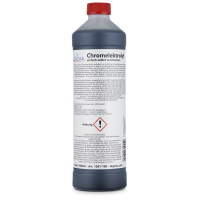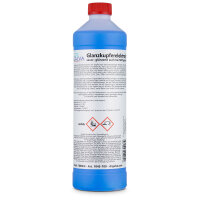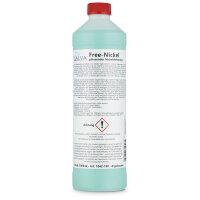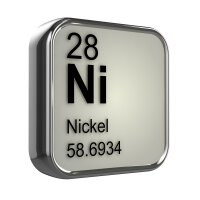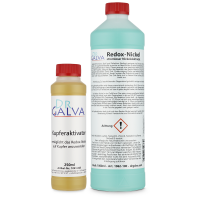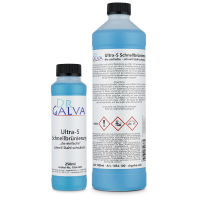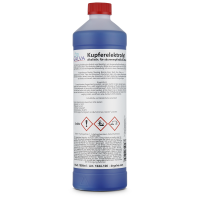Nickel-Strike macht Stähle und Edelstähle galvanisierfähig
Nickel-Strike oder Anschlagnickel wurde bereits in den 1890er-Jahren als Elektrolyt eingesetzt. Heute ist Nickelstrike in der Galvanotechnik unverzichtbar, um hochlegierte Edelstähle und Stähle für die Galvanisation vorzubereiten. Denn die auf der Oberfläche hochlegierter Metalle vorhandenen Oxide beeinträchtigen die Haftfestigkeit der mittels Badgalvanik oder Stiftgalvanik / Tampongalvanik aufgebrachten Beschichtung. Daher ist die Vorbehandlung mit Schlagnickel (Nickel-Strike) erforderlich.
So wirkt Nickel-Strike
Eine Vorbehandlung mit Nickel-Strike bereitet die Oberfläche für nachfolgende Beschichtungen vor. Anschlagnickel eignet sich für die galvanische und stromlose Behandlung. Es ätzt die Oberfläche des Werkstücks an, löst enthaltenes Chrom auf und erzeugt im Zuge dieser Reaktion eine Grundschicht aus Nickel. Diese mikrodünne Nickelschicht bildet nun eine zuverlässig haftstarke Basis für weitere Beschichtungen.
Im Idealfall bringen Sie nach der Behandlung mit Schlagnickel und vor der Endbeschichtung des Werkstücks eine Zwischenschicht auf. Diese besteht aus Kupfer oder aus chemischem oder galvanischem Nickel. Ob die Beschichtung über die Verfahren Badgalvanik oder Stiftgalvanik / Tampongalvanik erfolgt, ist nicht relevant.
Anwendungsbereiche für Nickelstrike
Das Nickel-Strike-Verfahren umfasst ein sehr breites Anwendungsgebiet. Neben der Vorbehandlung hochlegierter Stähle und Edelstähle erfordern auch verschiedenste Buntmetalllegierungen diese Vorbehandlung. Dazu zählen vor allem Legierungen mit Silizium, Magnesium, Mangan, Blei, Wolfram oder Titan.
Bereits vernickelte Objekte, die über einen längeren Zeitraum der Luft ausgesetzt sind, verlieren die typischen Eigenschaften der Beschichtung. Es handelt sich dann um sogenannte passivierte Nickelschichten, die ein Tauchbad in Nickel-Strike reaktiviert.
Nickel-Strike für galvanische und stromlose Anwendung
Anschlagnickel eignet sich für alle galvanischen Verfahren von der Badgalvanik bis zur Stiftgalvanik / Tampongalvanik sowie für das stromlose Verfahren.
Anwendungsgebiete:
Vor der Anwendung:
Beseitigen Sie Fette und Öle besonders gründlich durch den Einsatz von Alkohol. Schmutz und Rost entfernen Sie bitte mit entsprechendem Werkzeug. Fassen Sie das Objekt ausschließlich mit Einweghandschuhen an und verhindern Sie auf diese Weise zuverlässig die Übertragung von Hautfett auf die Oberfläche.
Galvanisches Verfahren (mit Netzteil):
Anoden Badgalvanik: Graphit-, Nickel- oder Platinanoden.
Anoden Stiftgalvanik / Tampongalvanik: Graphit-, Nickel- oder Platinanoden, alternativ auch Edelstahlanoden möglich.
Parameter (diese können abweichen, bitte testen):
- Badgalvanik: 1,5-4,5V (ca. 2,5-3V empfohlen bei 10cm Abstand)
- Stiftgalvanik: 2,5-5V (ca. 3V empfohlen)
- Stromdichte: 8,5-25A/dm² (bis 50A/dm² mit Badbewegung)
- Arbeitstemperatur: 20-50°C
- Abscheidungsgeschwindigkeit: ca. 0,03µm/min bei 10A/dm² und 20°C
- pH-Wert: 1
Achtung:
bei Edelstahl: Anode auf Pluspol - Werkstück auf Minuspol
bei Nickel: Anode auf Minuspol - Werkstück auf Pluspol
Behandeln Sie das Werkstück mit der Stiftgalvanik oder dem Tauchverfahren ungefähr 10 bis 60 Sekunden. Spülen Sie das Werkstück anschließend kurz ab. Verarbeiten Sie Objekte aus Aluminium umgehend weiter, um eine erneute Oxydation zu verhindern.
Stromloses Verfahren (ohne Netzteil):
Geben Sie den Elektrolyten in ein geeignetes Gefäß und erwärmen das Schlagnickel auf eine Temperatur von 35 - 50°C. Nun legen Sie das zu beschichtende Objekt für 0,5 - 3 Minuten in das Tauchbad und spülen es abschließend kurz ab. Aluminiumobjekte bitte bei Raumtemperatur maximal 0,5 - 1 Minute einlegen!
Optional verwenden Sie den Anschlagnickel temperiert auf Raumtemperatur. Berücksichtigen Sie in diesem Fall jedoch die längere Verweildauer im Tauchbad.
Um ein erneutes Oxydieren zu verhindern, sollten die mit Nickelstrike behandelten Objekte innerhalb von 10 - 30 Minuten weiterverarbeitet werden. Bei Aluminium ist die umgehende Weiterverarbeitung erforderlich.
Vorsicht: Verwenden Sie immer Handschuhe und Schutzbrille und atmen Sie die Dämpfe / Aerosole nicht ein. Nur in gut belüfteten Räumen verwenden!
Kennzeichnung des Gemisches:
Nickel-Strike
(enthält Salzsäure, Nickelsulfamat, Nickeldiacetat, Nickeldichlorid, Nickel(II)-sulfat)
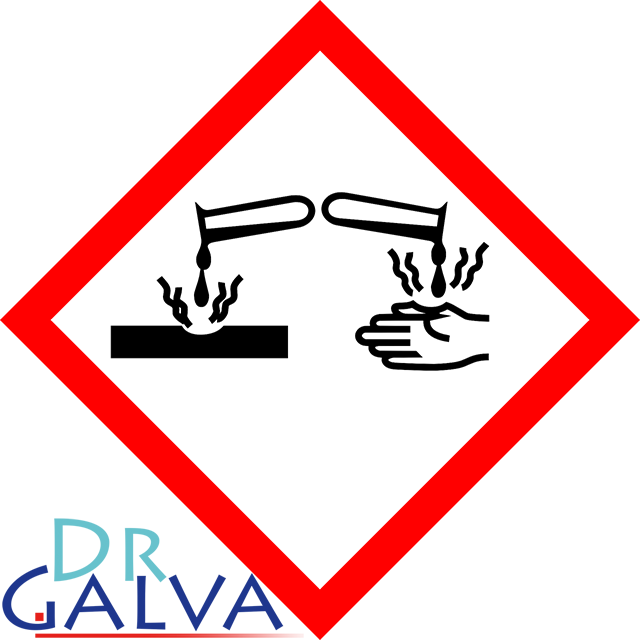

Signalwort: Gefahr
H290 Kann gegenüber Metallen korrosiv sein.
H314 Verursacht schwere Verätzungen der Haut und schwere Augenschäden.
H317 Kann allergische Hautreaktionen verursachen.
H335 Kann die Atemwege reizen.
P102 Darf nicht in die Hände von Kindern gelangen.
P103 Lesen Sie sämtliche Anweisungen aufmerksam und befolgen Sie diese.
P260 Staub/Dampf/Aerosol nicht einatmen.
P280 Schutzhandschuhe und Augenschutz/Gesichtsschutz tragen.
P301+P330+P331 BEI VERSCHLUCKEN: Mund ausspülen. KEIN Erbrechen herbeiführen.
P302+P352 BEI BERÜHRUNG MIT DER HAUT: Mit viel Wasser waschen.
P333+P313 Bei Hautreizung oder -ausschlag: Ärztlichen Rat einholen/ärztliche Hilfe hinzuziehen.
P305+P351+P338 BEI KONTAKT MIT DEN AUGEN: Einige Minuten lang behutsam mit Wasser ausspülen. Eventuell vorhandene Kontaktlinsen nach Möglichkeit entfernen. Weiter ausspülen.
P310 Sofort GIFTINFORMATIONSZENTRUM/Arzt anrufen.
P501 Inhalt/Behälter nicht mit dem Hausmüll entsorgen und gemäß den regionalen/nationalen Vorschriften der Entsorgung zuführen.
EUH071 Wirkt ätzend auf die Atemwege.
